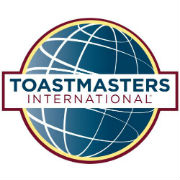
The Toastmaster of the meeting has the key role in the success of the meeting. The primary duty of the Toastmaster is to ensure a well-run, on-time, up-beat meeting and act as a genial host to smooth the transition between program participants. You’ll work on the art of introductions and lectern etiquette.
Before the Meeting:
1. Select a theme for the meeting (check with the Educational Vice President to determine if a theme has already been planned). The theme introduction should take no more than a couple of minutes.
2. Contact program participants early (several days before the meeting if possible). If substitutes are needed, this will provide time to find them. Also, some participants may have forgotten they are on the program. Early contact gives participants time to prepare.
- Table Topics Master
- Club Coach (If applicable remind the Club Coach to contact the Timer, Ah Counter, Grammarian, Ballot Counter and Coach.)
- Speakers
(If anyone indicates they cannot wear the hat assigned to them, remind them that it would be helpful if they would find a replacement. Alert the Educational Vice President of any vacancies and assist, if necessary, in recruiting substitutes.)
3. Focus on key program participants: Speakers and Table Topics. These roles require more preparation. It is typically easy to recruit substitutes at the meeting for the other hats.
4. Let the Table Topics Master and Club Coach know what the theme is. Ideally, everyone should follow the same theme throughout the meeting (except for the speakers).
5. Get whatever information you need from your Speakers so that you may properly introduce them. (See “Speaker Information Sheet.”)
6. Create and print your Meeting Agenda for the audience. (Click here for Standard Meeting Format). This is usually done the day prior to the meeting as participants may change right up to the last minute. If you are new to the Toastmaster hat, consult the Vice President Production for help on creating and printing an agenda.
7. Remember that it is your meeting! How smoothly and professionally the meeting goes will be a function of how much time and effort you have put into planning. A poorly planned meeting always looks it. A job well done does not happen by accident. Be encouraging and supportive to those who will be on your program. Get them enthusiastic about their roles and it will make for an enthusiastic meeting for all. Use your theme as a vehicle for introducing them. Above all, don’t forget to have fun!
At the Meeting:
1. Arrive early.
2. In conjunction with the Educational Vice President, check the agenda with participants that arrive. Give any changes to the President, who will announce the changes at the opening of the meeting.
3. Take a seat near the lectern.
4. When the President turns control of the meeting over to you, move to the lectern and shake the President’s hand. Now you are in charge of the meeting.
5. For an outline to use in the meeting, follow guidelines included in the “Toastmaster Checklist.”
6. You always lead applause:
- After introducing the Table Topics Master and Club Coach, and after they have concluded.
- After introducing a speaker, and after the speaker concludes.
7. Practice lectern etiquette. Never leave the lectern unattended.
8. If the Table Topics Master or Club Coach forgets to call for timers report or for votes, YOU call for timers report and remind the audience to vote for their favorite table topic response or coach.
9. Plan to return control to the President by specified time. You may have to ask functionaries to expedite their reports or shorten the time allotment for coaches to bring the meeting in on-time. Be sure to thank everyone for his or her participation. Gratitude is the attitude!
The Renaissance Speakers is an award-winning and prominent Toastmasters club hosted by the Church of Scientology in Pasadena, California. Join us this weekend for a little “Saturday Night Live on Sunday Morning!” We meet from 9:00am to Noon, each and every Sunday. ALL ARE WELCOME!
